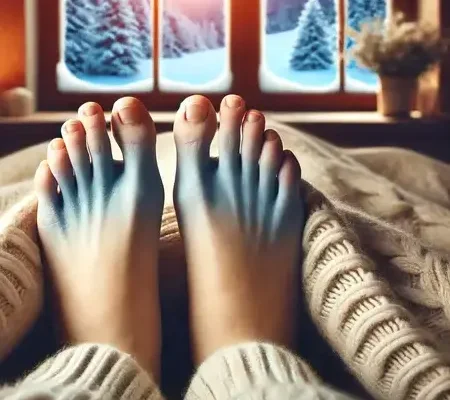You’re sitting at home, cozy in a blanket, but no matter how warm the room is, your toes still feel like ice. You put on thick socks, move around, and try to warm them up, but the coldness just won’t go away. Cold toes may seem like a small inconvenience, but when they persist, they can be a sign of an underlying issue.
Symptom Breakdown:
Cold toes are often a symptom of poor circulation or other health-related conditions. Understanding what might be causing this sensation can help identify if it’s something temporary or if further investigation is needed. Here are some key signs to look for:
- Persistent Coldness: If your toes are always cold, even in warm environments, this may indicate a deeper problem.
- Numbness or Tingling: Cold toes often come with tingling sensations, indicating that something is affecting the nerve function or blood flow.
- Color Changes: Toes that turn white, blue, or purple in response to cold could signal poor blood circulation.
- Pain or Sensitivity: If the cold is accompanied by pain or increased sensitivity, it might indicate a more serious underlying condition.
Diagnostic Path: Common Causes of Cold Toes
Toes that are consistently cold could be related to several health conditions. A doctor might consider the following:
- Poor Circulation (Peripheral Artery Disease):
Cold toes are frequently the result of reduced blood flow. Peripheral artery disease (PAD) is a common cause, where narrowed arteries limit the flow of blood to your extremities, making them feel cold or numb. - Raynaud’s Disease:
Raynaud’s causes blood vessels in your extremities (like toes) to narrow when exposed to cold or stress. This can lead to toes feeling cold, and in some cases, turning white or blue until circulation improves. - Hypothyroidism:
When your thyroid doesn’t produce enough hormones, your metabolism slows down, and your body may have trouble regulating temperature. Cold toes can be a side effect of this condition. - Anemia:
If you’re low on iron, your red blood cells may struggle to carry oxygen efficiently, leading to cold extremities, including your toes. - Diabetes:
People with diabetes may experience nerve damage (neuropathy) which can lead to a loss of sensation or persistent coldness in the toes due to poor circulation. - Frostbite:
Exposure to extreme cold can cause frostbite, where the skin and tissues freeze, leading to ongoing coldness or numbness even after you’ve warmed up.
Deep Dive: Circulation and Cold Toes
Circulation plays a critical role in maintaining warmth in your extremities. When blood flow is restricted or when nerves controlling circulation are damaged, the toes are often the first to feel the effects. For instance, in cases of peripheral artery disease or diabetic neuropathy, blood flow is reduced due to arterial blockages or damaged nerves, making it harder for your body to maintain warmth in the toes.
In Raynaud’s disease, the body overreacts to cold or stress, causing blood vessels to constrict and limit blood supply to the toes. This condition can leave you with icy feet, especially in colder climates or under stress.
Treatment Comparison: How to Address Cold Toes
Dealing with consistently cold toes can be frustrating, but several treatments and lifestyle changes may help:
- Improving Circulation:
- Exercise: Regular physical activity helps stimulate blood flow to your extremities.
- Quit Smoking: Smoking narrows blood vessels, reducing circulation, particularly in the toes.
- Compression Socks: These special socks can help improve blood flow in cases of mild circulation issues.
- Medical Treatment:
- Medications for Circulation: For PAD or Raynaud’s disease, medications like calcium channel blockers can improve blood flow by widening blood vessels.
- Thyroid Treatment: If hypothyroidism is causing your cold toes, medication to regulate thyroid hormone levels can help.
- Self-Care:
- Keep Warm: Wearing insulated socks or using heated insoles can help keep toes warm.
Outcome Story: A Path to Warm Toes
Let’s take the story of Jane, who was constantly struggling with cold toes, especially during the winter. She tried layering socks and using space heaters, but the cold never went away. After a visit to her doctor, she was diagnosed with Raynaud’s disease. With a combination of medications to improve circulation, learning how to manage her stress, and keeping her feet warm in the winter, Jane finally felt relief.
Take Cold Toes Seriously
Cold toes may seem like a minor inconvenience, but when they persist, they can signal underlying health issues. From circulation problems to hormonal imbalances, it’s important to identify the cause and treat it accordingly. If you’re struggling with cold toes that don’t seem to warm up, reach out to a healthcare professional to discuss possible treatments and ensure it’s nothing serious.









